Enhancing Morgue Safety and Efficiency with Modern Lifting Solutions
Mopec cadaver lifts are specialized hydraulic lifting devices designed to safely transport deceased individuals within morgue, hospital, and research environments. These lifts eliminate manual handling risks while improving workflow efficiency.
| Quick Facts: Mopec Cadaver Lifts | Details |
|---|---|
| Weight Capacity | 750-1000 lbs depending on model |
| Lift Height Range | 13.3" to 76.7" (compatible with five-tier racks) |
| Key Models | JD950 (with digital scale), Red Wing Series, JD450 Fork Style |
| Power Source | 12 VDC sealed deep cycle batteries |
| Unique Features | Digital scales, roller-ball tops, adjustable forks |
| Safety Features | Emergency stop, locking casters, overload protection |
In today's mortuary and pathology environments, manually lifting and transporting deceased individuals poses significant safety risks to staff. A quality cadaver lift system not only protects your team from workplace injuries but also improves operational efficiency and maintains dignity in handling.
The right Mopec cadaver lift can transform your facility's workflow, reducing the need for multiple staff members during transfers while ensuring precise alignment with storage racks, autopsy tables, and cooler systems.
I'm Mortuary Cooler, and I've helped hundreds of funeral directors and morgue facilities select and integrate the appropriate Mopec cadaver lift systems to complement their existing mortuary coolers and workflow requirements. My experience with Mopec cadaver lift selection spans decades of working with facilities of all sizes, from small funeral homes to large medical examiner offices.
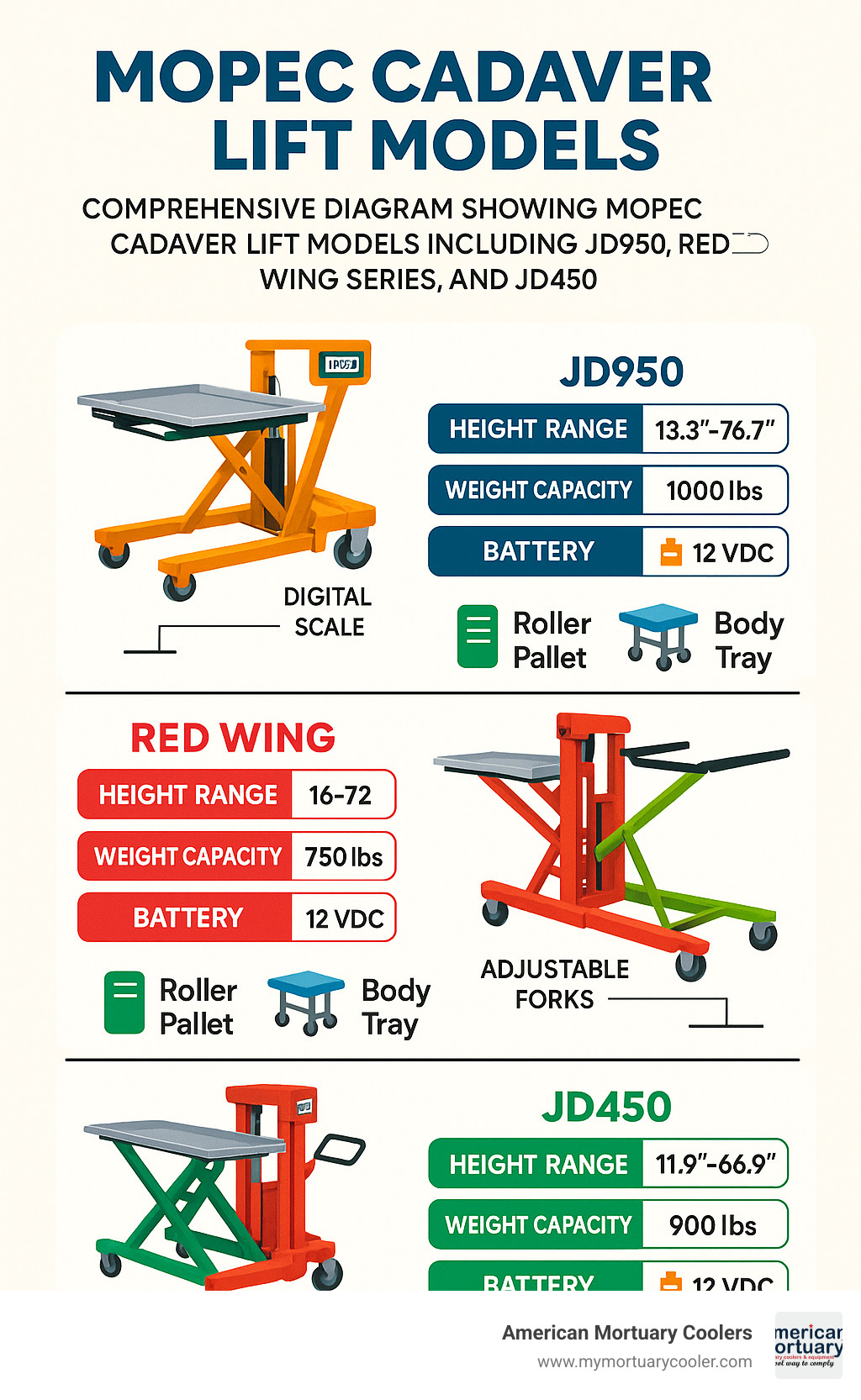
Mopec cadaver lift word list:
Understanding the Mopec Cadaver Lift
In my years at American Mortuary Coolers, I've seen how the right equipment transforms a facility's workflow. The Mopec cadaver lift is truly the unsung hero of the morgue environment – it's the bridge that connects every workstation in your facility while keeping your team safe.
At its core, a Mopec cadaver lift is a specialized mobile hydraulic scissor lift designed with one purpose: safely moving and elevating the deceased. These lifts use a clever hydraulic scissor mechanism powered by a 12-volt deep cycle battery system, giving you complete freedom to move throughout your facility without tripping over power cords.
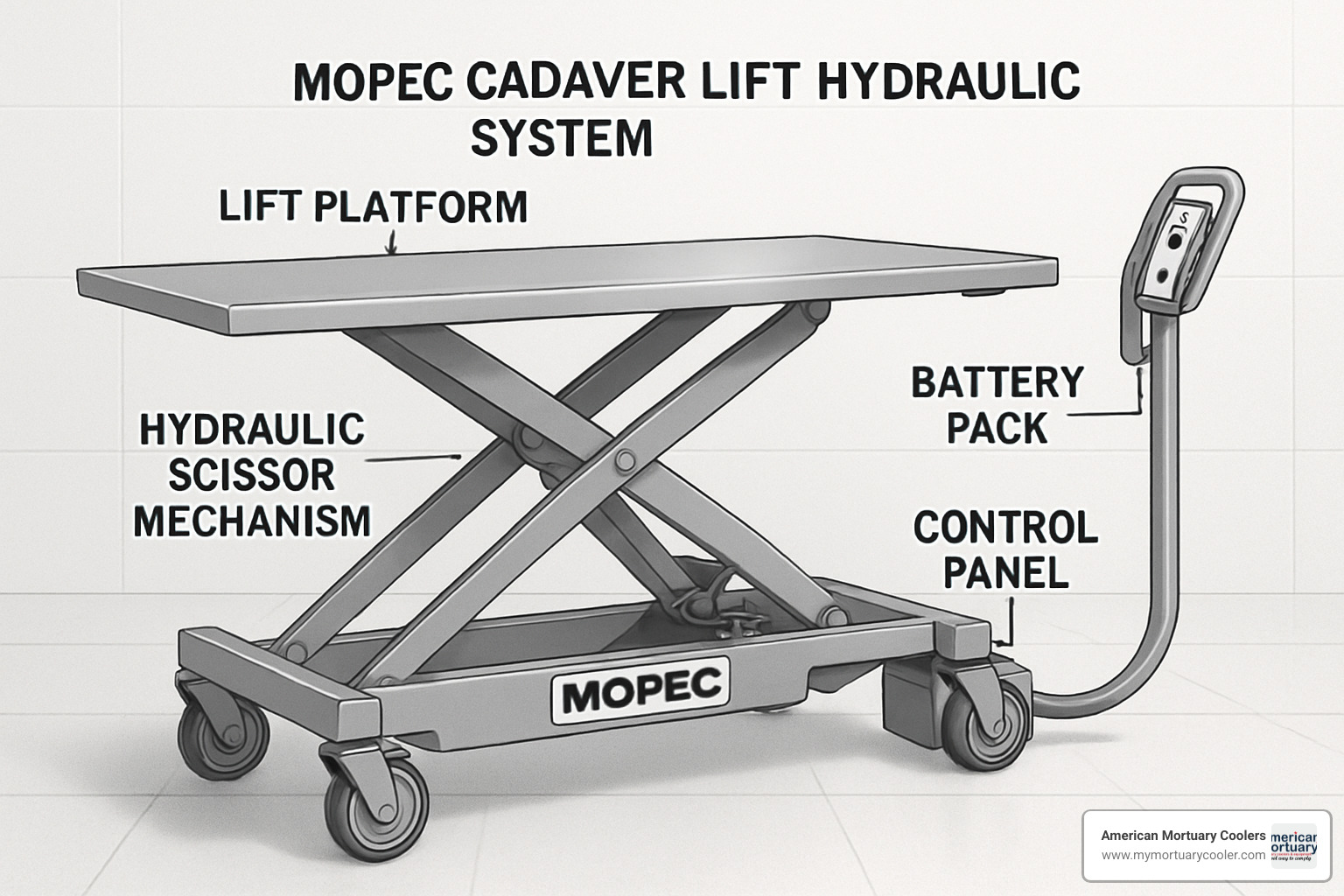
What makes these lifts invaluable is how they eliminate manual lifting – the number one cause of workplace injuries I see in morgue settings. With impressive weight capacities between 750 and 1000 pounds, these workhorses handle even bariatric cases with dignity while precisely aligning with your storage racks, autopsy tables, and transport vehicles.
Many facilities I work with particularly love the JD950 model with its built-in digital scale that displays weight in pounds or kilograms. This simple feature eliminates an entire step in your intake process – no more separate weighing procedures.
What Is a Mopec Cadaver Lift?
Think of the Mopec cadaver lift as your facility's most reliable team member. It serves multiple essential functions:
It enables safe transfers between surfaces without manual lifting, whether you're moving from stretchers to autopsy tables or into cooler trays. It provides a dignified way to transport the deceased throughout your facility. Perhaps most importantly, it allows a single staff member to safely complete tasks that used to require two or three people.
I remember what one medical examiner's office manager told me after we installed their first lift: "Before our Mopec cadaver lift, we had at least one staff injury every quarter from manual transfers. In the two years since, we've had zero lifting-related incidents." That's the kind of change I love to see.
These aren't generic material handling equipment – they're specifically designed for the unique demands of mortuary workflows and built for daily use in challenging environments.
How the Hydraulic System Works
The magic behind every Mopec cadaver lift is its hydraulic system – the mechanical muscle that lets you safely lift substantial weight with minimal effort.
Most Mopec models use a single scissor design with a compact hydraulic actuator. This clever self-contained unit houses everything together – the hydraulic pump, reservoir, and cylinder. When you press the button on the control console, the electric motor (powered by that 12 VDC sealed deep cycle battery) drives the hydraulic pump. This pressurizes fluid into the cylinder, extending the scissor mechanism and smoothly raising the platform.
The JD950 model, a favorite among my clients, performs about 30 complete up/down cycles on a single battery charge. The battery typically lasts about 12 months with normal use and takes between 4-24 hours for a full recharge with the included 110/220V charger.
What's happening inside the hydraulic system is fascinating. The electrically-driven hydraulic pump creates pressure in the system. The hydraulic cylinder converts that fluid pressure into smooth linear motion. A control valve regulates fluid flow for precise movement. Meanwhile, a sealed reservoir contains the hydraulic fluid, and a relief valve prevents system overload by releasing excess pressure if needed.
The engineers at Mopec have thoughtfully incorporated pinch-point protection and carefully calibrated descent speeds to ensure safe, controlled lowering even with maximum loads.
Built-In Safety Features & Controls
When it comes to mortuary equipment, safety isn't just a feature – it's a requirement. Mopec cadaver lifts shine here with numerous protections for both operators and the deceased:
The Emergency Stop (E-Stop) is a prominent red button that immediately halts all lift operations in an emergency situation. You'll appreciate the locking casters – most models feature three or four swivel casters that lock securely in position during loading and unloading. The overload protection system automatically prevents operation if weight exceeds the rated capacity, protecting both equipment and staff.
OSHA-compliant labeling clearly identifies pinch points and operational hazards, while the intuitive control console features an ergonomic design with simple up/down controls and battery status indicators.
Most models feature a handle-mounted console for one-handed operation while maneuvering the lift. The JD950 includes a digital display showing both weight and battery status, giving operators critical information at a glance.
I still remember what a safety consultant told me during a recent hospital installation: "The thoughtful placement of the E-stop button and the audible warnings during operation significantly reduce risks compared to our previous equipment."
These safety features aren't just about compliance – they're about creating peace of mind for your team during what can already be emotionally challenging work.
Key Models in the Mopec Lineup
Mopec offers several distinct cadaver lift models, each designed to address specific facility needs and workflow requirements. At American Mortuary Coolers, we've installed and integrated all of these models across various facilities nationwide, giving us unique insight into their real-world performance.
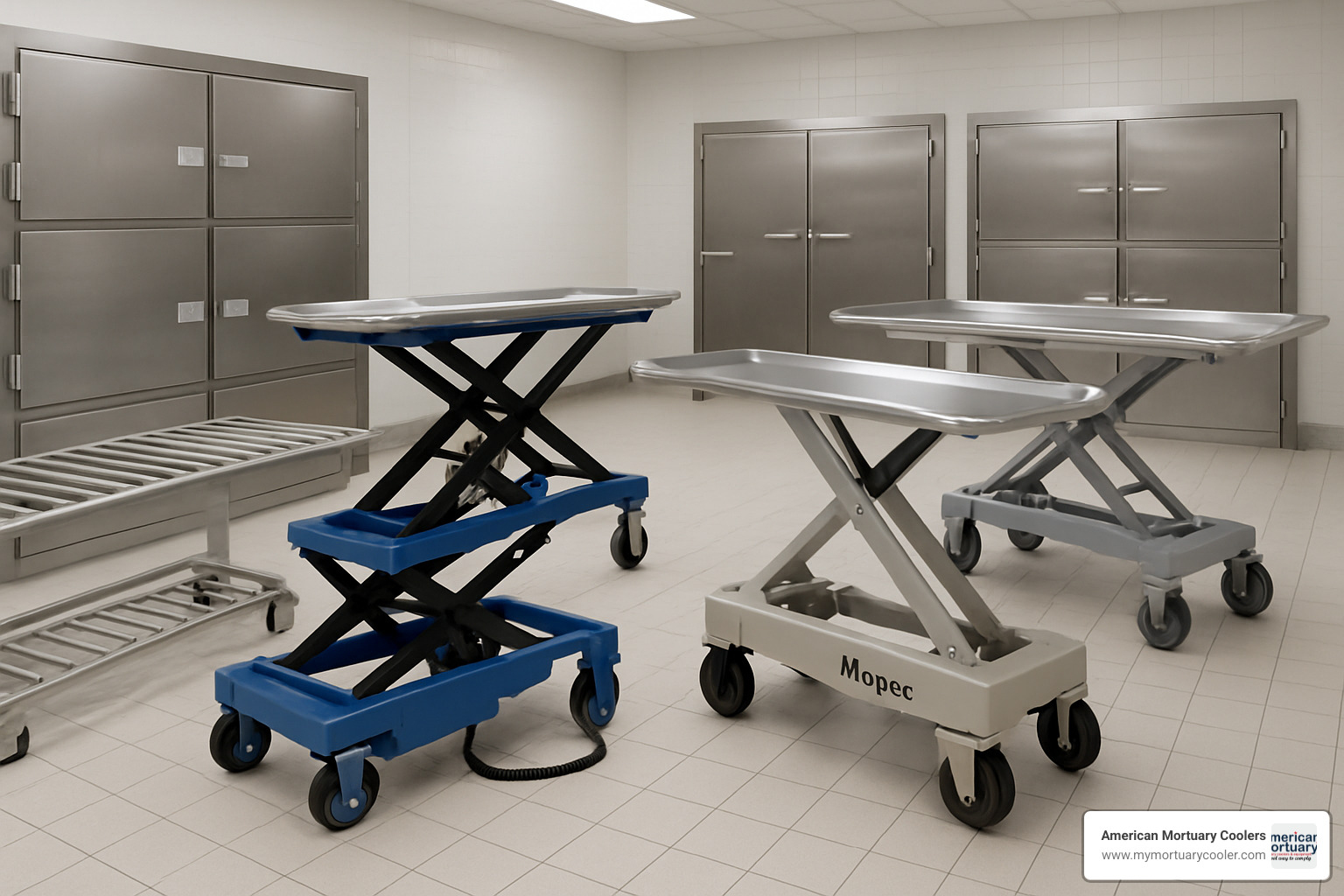
I remember walking through a newly renovated morgue with a facility director who couldn't stop smiling as she showed me their new Mopec cadaver lift lineup. "These aren't just pieces of equipment," she told me, "they're like extra staff members who never call in sick."
The Mopec family ranges from high-tech scissor lifts with built-in scales to specialized fork-style models that glide across floors with roller pallets. There's a perfect match for every facility, whether you're running a small funeral home or a busy medical examiner's office.
JD950 Mopec Cadaver Lift: Integrated Scale & Heavy Capacity
The JD950 is what I like to call the "Swiss Army knife" of the Mopec cadaver lift world. It's their premium model featuring something that saves countless hours - an integrated digital scale system. This clever addition continuously displays weight in pounds or kilograms, eliminating separate weighing steps during intake.
The JD950 brings some impressive capabilities to your facility:
Weight Capacity: It handles up to 750 lbs for lifting, while the digital scale measures up to 1000 lbs - perfect for bariatric cases that are becoming more common.
Elevation Range: From a low 14-5/8" (37cm) up to 75-5/8" (190cm) - enough range to work with virtually any table or storage system.
Battery Performance: You'll get about 30 complete up/down cycles per charge, easily covering a busy day's work.
One medical examiner's facility in Chicago told me the integrated scale feature alone saved their staff about 15 minutes per case. In their high-volume operation, that translated to over 10 hours saved weekly - essentially freeing up more than one full workday!
Red Wing Series Mopec Cadaver Lift: Five-Tier Reach
The Red Wing Series (including the JD5000 and JD501 models) is the high-reaching specialist in the Mopec cadaver lift family. These models are built specifically to service those tall five-tier storage racks that maximize cooler space.
What makes the Red Wing series special is its clever top design - either a roller ball top (JD5000) or split roller top (JD501) that allows cadaver trays to be transferred from any direction. This 360-degree loading capability is a game-changer in tight spaces.
With an impressive elevation range from 13.3" all the way up to 76.7" and a solid 800 lb capacity, these workhorses handle almost any morgue situation with ease. They're powered by 12 VDC sealed deep-cycle batteries with a 110/220 V charger, ensuring reliable performance shift after shift.
I'll never forget what a funeral home director in Tennessee told me after we installed their Red Wing lift: "This has completely transformed our preparation room. With our tight space, loading from any side means we're not constantly doing the morgue shuffle with our equipment. It's like our little room suddenly got bigger!"
JD450 Fork-Style & Companion Pallets
The JD450 Series takes a different approach to the Mopec cadaver lift concept. Instead of a traditional platform, these models use adjustable forks designed to work with roller pallets (JD400, JD410, JD420) or directly with cadaver trays.
This modular approach gives you flexibility when dealing with varying tray sizes or if you're transitioning between different equipment types. With weight capacities up to 1000 lbs and maximum lift heights of 64" (JD450) or 76" (JD451), these lifts handle even the most demanding situations.
What really sets the JD450 series apart is its powered mobility feature. The forward/backward movement controlled via the steering handle makes this the perfect solution for facilities where staff need to transport deceased individuals between buildings or across longer distances.
A hospital system in Dallas implemented these lifts specifically because their morgue and pathology departments were in separate buildings. As their facilities manager told me with a relieved smile, "Before, we dreaded those long transports. Now, one person can handle it safely, and without feeling like they've run a marathon afterward."
The JD450's compatibility with JD460 Adjustable Forks means it works with trays from 30" to 32" wide, making it adaptable to virtually any existing tray system your facility might have.
Choosing Specifications & Features That Matter
When I'm helping our clients find the perfect Mopec cadaver lift, I always focus on what really matters for their specific facility. It's not just about buying equipment—it's about finding a solution that makes your daily operations safer and more efficient.
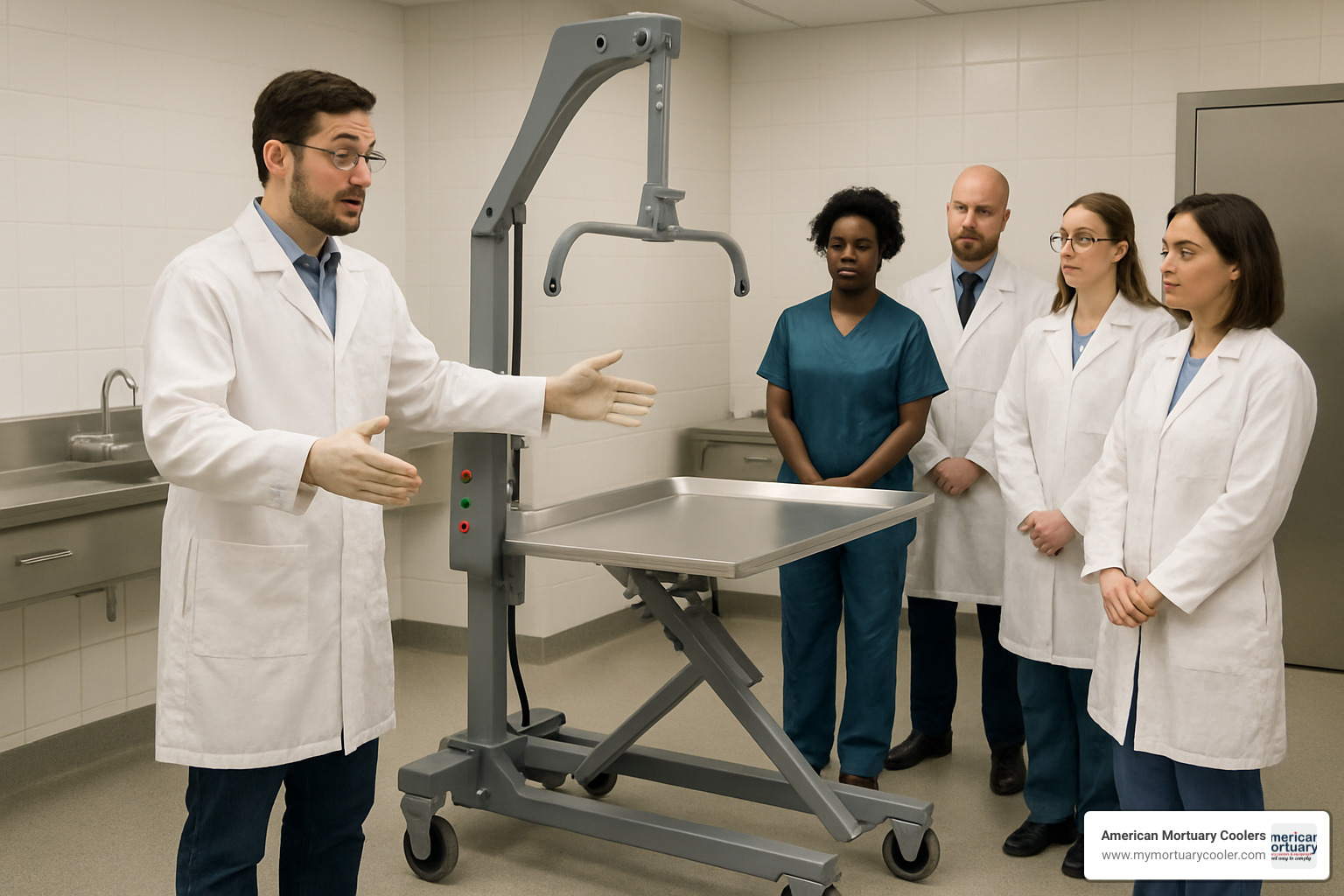
Let me break down how these models compare side-by-side:
| Feature | JD950 | Red Wing JD5000 | JD450 Fork Style |
|---|---|---|---|
| Weight Capacity | 750 lbs (lift) / 1000 lbs (scale) | 800 lbs | 1000 lbs |
| Maximum Lift Height | 75-5/8" (190cm) | 76.7" | 64" (JD450) / 76" (JD451) |
| Minimum Height | 14-5/8" (37cm) | 13.3" | Not specified |
| Battery Life | ~30 cycles per charge | Not specified | Not specified |
| Special Features | Integrated digital scale | Roller ball top for multi-directional loading | Powered mobility controls |
| Compatible Tray Width | Adjustable | 23" to 30" | 23", 27", 30"-32" with JD460 forks |
| Approximate Weight | 575 lbs | 700 lbs | Not specified |
I remember working with a medical examiner's office in Memphis who initially balked at the price difference between the basic model and the JD950 with its integrated scale. Six months later, their director called me just to say thanks—that scale feature alone had saved them countless hours of documentation time and eliminated transcription errors completely.
Weight capacity should be your first consideration. If you regularly handle bariatric cases, the JD450's 1000-pound capacity provides necessary peace of mind. One funeral director told me, "Having that extra capacity meant we never had to worry about turning families away."
Lift height range directly impacts your storage options. For facilities with five-tier rack systems, the Red Wing series or JD451 models are your best bet. Their extended reach eliminates the need for staff to manually transfer between the lift and highest racks—a common injury point in many facilities.
Tray compatibility might seem obvious, but I've seen facilities purchase lifts only to find they don't properly align with their existing trays. Most facilities use standard 23" or 27" trays, but if you're using wider 30"-32" models, you'll need the JD460 adjustable forks on the JD450 series.
The control system design affects daily usability more than you might expect. The JD950's integrated console with weight display keeps essential information at your fingertips. As one pathology tech told me, "Not having to mentally track or write down weights during transfers has been a huge stress reliever."
Battery life considerations should match your facility's case volume. The JD950's approximately 30 cycles per charge works well for most facilities, but busier operations might consider keeping a spare battery on hand for quick swaps during high-volume periods.
That digital scale integration on the JD950 isn't just convenient—it's a workflow transformer. By eliminating separate weighing procedures, facilities save 5-10 minutes per case. For busy locations handling multiple cases daily, that quickly adds up to hours of reclaimed staff time each week.
I always encourage clients to think beyond the initial price tag and consider how these features translate to real-world efficiency. Learn more about how these lifts integrate with other equipment in Mortuary Lifts, Cadaver Lifts & Ceiling Lifts: Choosing the Right System.
For even more information about reliable lifting solutions, check out our guide on hydraulic body lifts that dives deeper into the technical aspects of these essential tools.
Workflow, Safety, and Ergonomic Advantages
The moment you bring a Mopec cadaver lift into your facility, you'll notice immediate improvements in how your team works. I've seen this change at countless facilities we've helped at American Mortuary Coolers.
The most dramatic benefit? Staff injuries plummet almost overnight. Manual lifting of deceased individuals is one of the biggest causes of workplace injuries in mortuary settings – injuries that can sideline your valuable team members for weeks or months. A good cadaver lift system removes this risk entirely by eliminating manual lifting from your workflow.
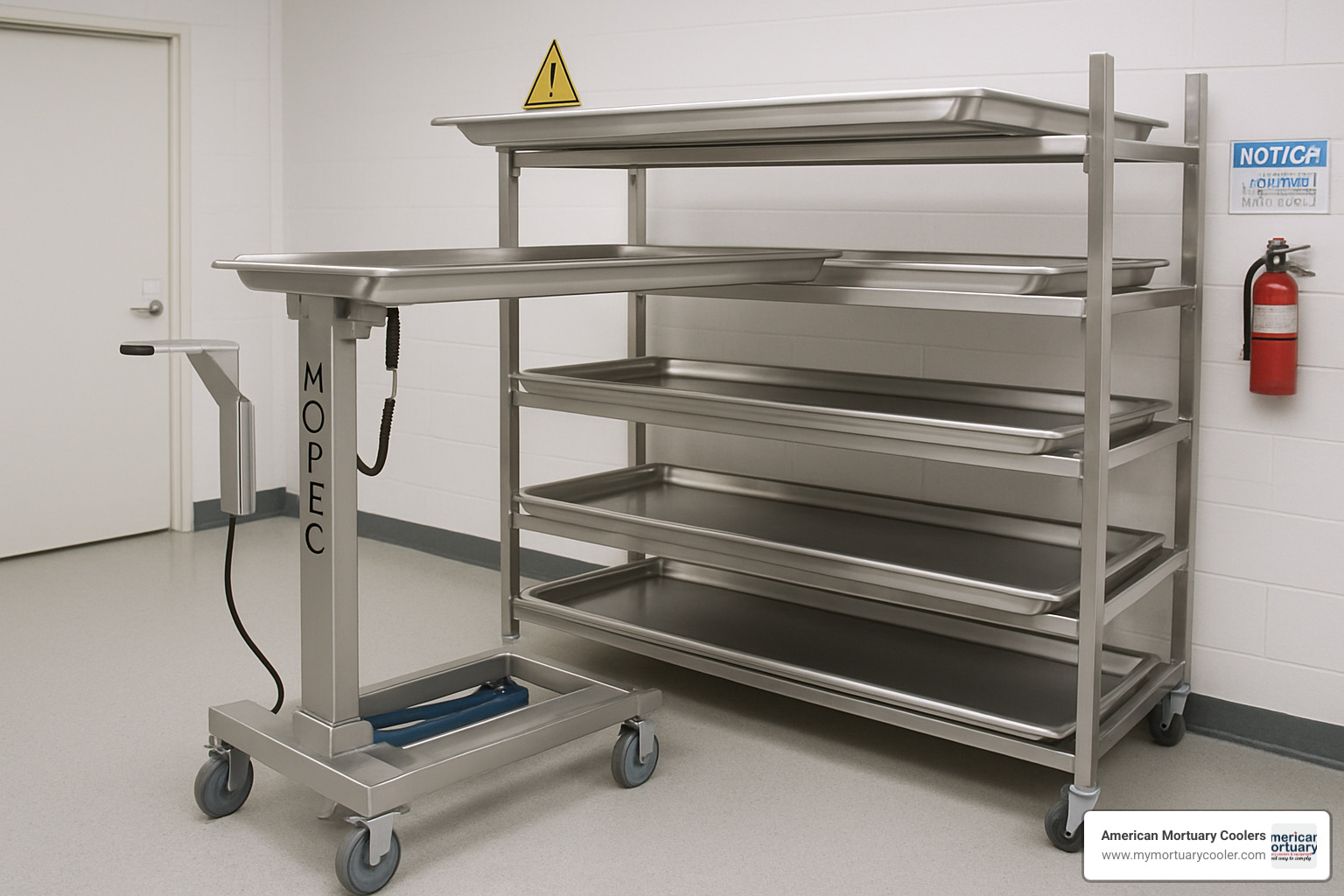
This isn't just my observation – the science backs it up. Research shows that mechanical lifting devices can reduce staff injuries by up to 80% in healthcare environments. While these studies primarily looked at patient handling, the same principles apply perfectly to mortuary work.
Beyond safety, you'll notice your team's workflow becomes smoother and more efficient. Tasks that once required two or three staff members can often be handled safely by just one person with a Mopec cadaver lift. For facilities struggling with staffing shortages (and who isn't these days?), this benefit alone can be transformative.
Models with built-in scales, like the JD950, eliminate separate weighing steps – a small change that adds up to significant time savings over hundreds of cases. The variable height adjustment allows for perfect alignment with storage racks at any level, making transfers smoother and less physically demanding.
I still remember when the medical examiner's office in Columbia called me after installing their JD950. The director was almost giddy: "We've cut our intake time by 40%! And the staff actually fight over who gets to use the lift now instead of dreading transfers."
Perhaps most importantly, these lifts help maintain dignity in handling. Smooth, controlled transfers dramatically reduce the risk of accidents that could compromise the dignity of the deceased – something every mortuary professional takes seriously.
Accessories & Compatible Equipment
Your Mopec cadaver lift becomes even more valuable when paired with the right accessories. Think of these complementary items as creating a complete system that maximizes efficiency and safety.
Roller pallets (models JD400, JD410, and JD420) are game-changers for many facilities. These platforms feature roller balls or wheels that make transfers between surfaces almost effortless. They're especially valuable when used with fork-style lifts, creating a seamless transfer system.
Tray bars (JD500) secure body trays during transport, preventing any shifting or sliding – particularly important when moving through doorways or around corners. Body straps provide additional security, especially when navigating ramps or uneven surfaces.
The real magic happens when you integrate your lift with compatible storage systems. Mopec's IE-Series and current full-length roller racks work seamlessly with their lift systems. Built from Type 304 stainless steel with nylon roller wheel assemblies, these racks align perfectly with the lifts for smooth transfers.
For facilities planning for surge capacity (something we've all thought more about since 2020), Mopec's Guardian Containers include compatible lift mechanisms designed specifically for these specialized environments.
A typical workflow might look like this: your team uses a JD450 lift with JD460 adjustable forks to transport a JD400 roller pallet containing a deceased individual from intake to a five-tier storage rack. The roller pallet then facilitates a smooth transfer onto the rack's roller assembly – all with minimal physical strain and maximum dignity.
Comparing Mopec to Other Solutions
I've installed and serviced just about every brand of cadaver lift on the market, and Mopec cadaver lifts consistently stand out in several important ways.
First, they're purpose-built for mortuary work. This might seem obvious, but many competing products are actually adapted material handling equipment – basically warehouse lifts painted white. Mopec designs specifically for mortuary environments, with features like integrated scales, specialized tray compatibility, and finishes that stand up to frequent disinfection.
The system integration is another huge advantage. Mopec's comprehensive ecosystem of compatible equipment ensures everything works together seamlessly – lifts, racks, coolers, and transport devices all designed to complement each other.
When you need help (and eventually, everyone does), Mopec provides detailed technical drawings, comprehensive user manuals, and responsive technical support. This reduces downtime and ensures proper operation even as staff changes over time.
These lifts are built to last, too. The use of high-quality materials like Type 304 stainless steel and sealed hydraulic systems results in exceptional durability, even in the demanding environment of a busy morgue or funeral home.
When we integrate Mopec cadaver lifts with our American Mortuary Coolers systems, the result is a cohesive solution that addresses your entire workflow. Our custom cooler systems are designed with compatible dimensions and access points that align perfectly with Mopec lift specifications – no more awkward gaps or misalignments.
A funeral director in New York recently told me about switching from a generic material handling lift to a Mopec system: "The difference is night and day. Our old lift was constantly getting stuck at heights that didn't quite match our cooler shelves. The Mopec system aligns perfectly every time, and the controls are actually positioned for mortuary work, not warehouse operations."
For more insights on how these systems reduce workplace injuries, check out our article on lifting the burden: how mortuary scissor lifts are reducing workers' comp claims.
Ownership Essentials: Maintenance, Training, and Support
Owning a Mopec cadaver lift is a bit like having a reliable truck - it'll serve you faithfully for years, but only if you give it some regular TLC. After helping hundreds of funeral homes and medical facilities implement these systems, I've seen how proper care transforms a good investment into a great one.
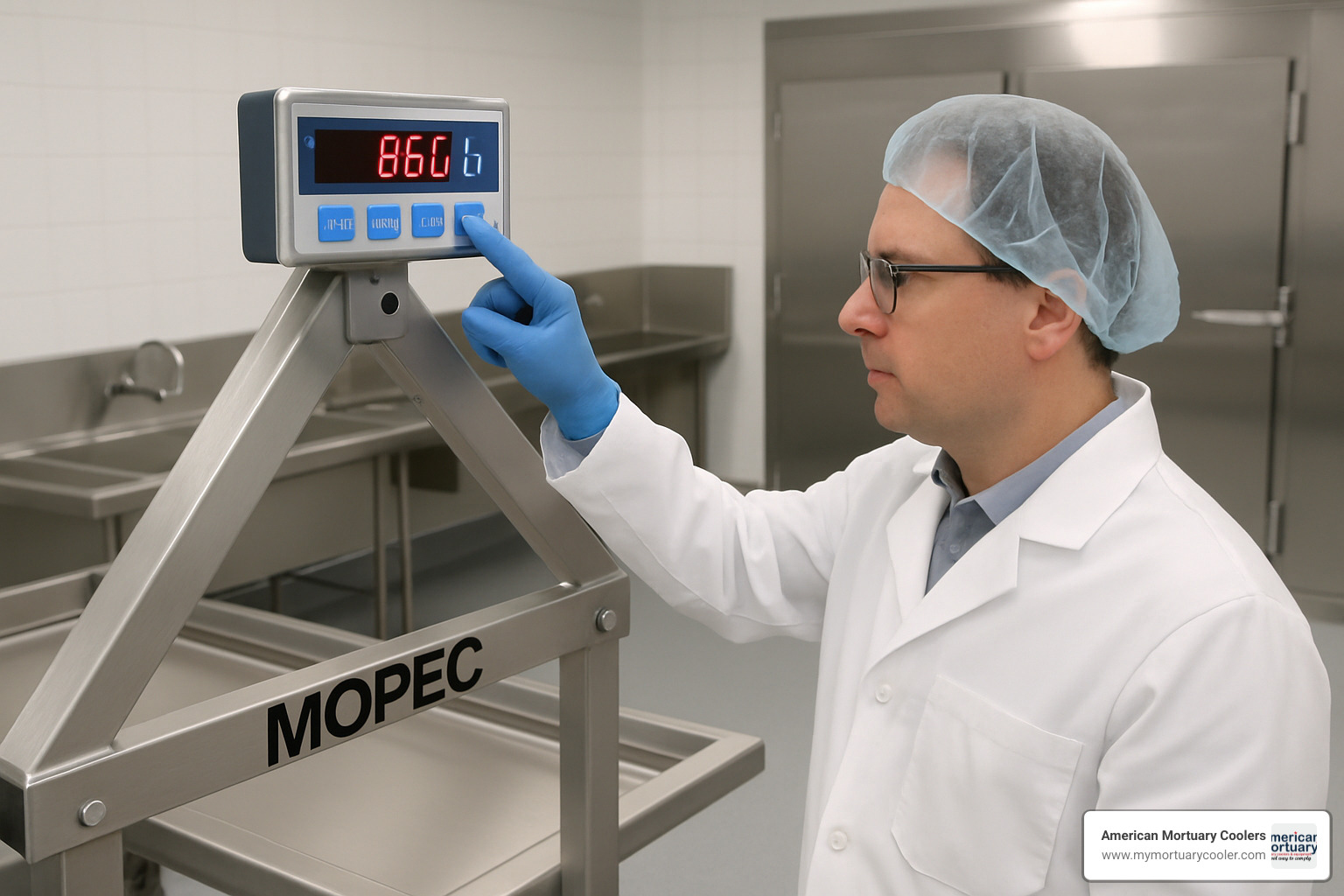
Maintenance Requirements
Your Mopec cadaver lift doesn't ask for much attention, but the little it does need is crucial. Think of battery care as your top priority - check water levels in lead-acid batteries quarterly (using only distilled water), and give them a full charge every 4-6 weeks even during slow periods. Most facilities find they need to replace batteries annually with normal use.
The hydraulic system is remarkably self-sufficient. A monthly visual check for leaks or damage keeps small issues from becoming big problems. The fluid level only needs annual verification, and you won't typically need regular fluid changes - a pleasant surprise for anyone used to maintaining hydraulic equipment.
If you've invested in a model with an integrated scale like the JD950, annual calibration ensures your weight measurements stay accurate. This isn't a DIY job - qualified technicians using certified weights should handle this task. I remember visiting a medical examiner's office that had skipped calibration for three years. Their weight measurements had drifted significantly, causing documentation headaches they could have easily avoided.
Don't forget the mechanical components. Monthly checks of caster wheels prevent debris buildup that can affect mobility. Test all locking mechanisms and the E-stop before each use (this takes seconds but prevents accidents), and give those roller balls or transfer mechanisms a quarterly once-over to ensure smooth operation.
As Mike, a maintenance manager at a Chicago hospital, told me: "We've found that consistent battery maintenance is the single most important factor in lift reliability. Since implementing a monthly battery check protocol, we've eliminated almost all unexpected downtime."
Operator Training
Even the best equipment is only as good as the people using it. Proper training on your Mopec cadaver lift isn't just about efficiency—it's about safety and dignity in handling.
Basic operation training should cover controls, movement procedures, and height adjustment. Transfer techniques need special attention, including proper alignment and tray loading/unloading procedures. Safety protocols deserve emphasis, particularly E-stop usage, pinch point awareness, and weight limits.
Don't overlook charging procedures and basic troubleshooting. I've seen facilities reduce their service calls by over 50% simply by teaching staff how to diagnose common issues.
Mopec provides comprehensive user manuals, and I strongly recommend implementing a certification program for operators. A training log and annual refresher sessions keep everyone sharp. I worked with a funeral home in Tennessee that turned their training into a friendly competition, with small rewards for perfect operation demonstrations—their equipment has lasted years longer than expected.
Warranty and Support
When you invest in a Mopec cadaver lift, you're not just buying equipment—you're entering a support relationship. Mopec's warranty typically covers parts and labor for 12 months from installation, and their technical support team is available via phone and email for troubleshooting assistance.
Replacement parts are readily available through authorized distributors, and detailed technical drawings can be requested for facility planning. If you're in a remote location, I recommend maintaining a small inventory of essential spare parts, particularly battery components and caster wheels.
At American Mortuary Coolers, we go a step further for the Mopec cadaver lifts we install, providing integration with our custom cooler systems and hands-on training during implementation. We've found that this comprehensive approach significantly extends equipment life and user satisfaction.
One funeral director in Maine summed it up perfectly: "The lift itself is great, but knowing I have someone to call when I have questions makes all the difference. That peace of mind is worth every penny."
For more information about training on mortuary lifts and how they're helping reduce workplace injuries, check out our article on lifting the burden: how mortuary scissor lifts are reducing workers' comp claims.
Frequently Asked Questions about Mopec Cadaver Lifts
After helping hundreds of facilities implement Mopec cadaver lifts over the years, I've noticed certain questions pop up time and again. Whether you're a funeral director wondering about maintenance or a hospital administrator concerned about compatibility, these answers should help clear things up.
How often should I charge and replace the battery?
Battery care is probably the most common concern I hear from new lift owners. The 12 VDC sealed deep cycle batteries in your Mopec cadaver lift aren't particularly demanding, but they do appreciate a bit of attention.
I usually tell people to charge whenever the indicator drops below 25% capacity, which typically happens after 20-30 complete lift cycles. For the best battery life, try to do complete charge cycles (which take anywhere from 4-24 hours) rather than frequent little top-ups.
One director I worked with in Seattle had a great system: "We just plug it in every Friday afternoon before leaving. That way, it's always ready for Monday morning, and we never have to worry about unexpected battery issues during the week."
Even if your lift sits idle for a while, give it a charge every month or so. Under normal usage, plan to replace the battery annually – you'll notice when it's time because you'll get fewer cycles per charge and it'll take longer to juice up.
Are Mopec cadaver lifts compatible with existing five-tier racks?
"Will this work with what I already have?" is a question I hear constantly, and fortunately, the answer is usually yes. Mopec cadaver lifts are specifically designed to play nice with standard mortuary storage racks, including those towering five-tier systems.
If you're working with five-tier racks, you'll want to look at either the Red Wing Series (JD5000/JD501) or the JD451 fork-style lift. Both are designed to reach those upper heights with maximum elevations of 76.7" and 76" respectively.
Before you commit, though, I always recommend double-checking a few things:
- Make sure the lift's maximum height can reach your highest rack position
- Verify that your trays match the lift's width capacity (most Mopec lifts handle standard 23" and 27" trays)
- For non-Mopec racks, measure the clearance under your lowest rack to ensure the lift can slide underneath
I remember helping a funeral home in Ohio that had some custom-built racks from the 1990s. We weren't sure if the Mopec lift would align properly, so we requested the technical drawings from Mopec and took some careful measurements. Everything worked perfectly, and they've been using that same system for years now.
What warranty and service response times can I expect?
Nobody likes downtime, especially in our industry. Mopec typically covers their cadaver lifts with a 12-month warranty on both parts and labor, protecting you against manufacturing defects and component failures under normal use.
When it comes to service response, several factors come into play. If you're in a major city, you'll generally see faster service than if you're in a remote location. Critical failures that leave you without a functioning lift get priority attention, and common parts are usually readily available (though specialized components might need ordering).
When you purchase through us at American Mortuary Coolers, we provide additional support with typical response times of 24-48 hours for urgent issues. Many of our clients also appreciate our preventive maintenance programs, which can catch small problems before they turn into workflow-disrupting emergencies.
One of our hospital clients in Los Angeles had a great experience with support: "When our JD950's control panel started acting up, the tech support team walked us through a simple reset over the phone. We were back up and running within an hour. For the more complicated stuff, they've always had someone on-site within two days."
In my experience, most issues with Mopec cadaver lifts are either battery-related or simple mechanical adjustments that can often be resolved with phone support. That's a testament to their solid construction and thoughtful design.
Conclusion
Choosing the right Mopec cadaver lift isn't just about buying equipment—it's about investing in your staff's wellbeing, your facility's efficiency, and the respectful handling of those in your care. After helping hundreds of facilities make this important decision, I've seen how the right lift transforms daily operations.
When you're ready to bring a Mopec cadaver lift into your facility, follow these steps for the smoothest implementation:
Start with a thorough assessment of your specific needs. How many cases do you handle daily? What tray sizes do you use? How tall are your storage racks? Is your workspace tight or spacious? These answers will guide your decision-making process.
Next, select the model that fits your requirements. Maybe you need the JD950's integrated scale to streamline your intake process, or perhaps the Red Wing's five-tier reach is essential for your storage system. Investing in the right features now prevents headaches later.
Planning for integration is where many facilities stumble. At American Mortuary Coolers, we specialize in ensuring your new lift works seamlessly with your existing equipment—especially your cooler systems. Our custom cooler solutions are designed with Mopec cadaver lift compatibility in mind, creating a workflow that feels like it was built as a single system.
Staff training deserves your attention too. Even the best equipment can cause problems in untrained hands. Take time to properly train everyone on operation, safety protocols, and basic maintenance. This investment in knowledge pays dividends in equipment longevity and staff confidence.
Finally, establish a regular maintenance schedule. Simple routines like battery care and scale calibration prevent costly downtime. Mark these tasks on your calendar—your future self will thank you.
The benefits of a quality Mopec cadaver lift extend far beyond the obvious safety improvements. Facilities consistently tell me about unexpected advantages: transferring tasks now require just one person instead of three, documentation time plummets with integrated scales, insurance costs decrease, equipment lasts longer, and staff morale improves dramatically.
A medical examiner I worked with in Pittsburgh put it perfectly: "Our Mopec cadaver lift paid for itself within the first year just in reduced overtime costs, as we no longer needed to maintain minimum staffing levels solely for safe transfers."
At American Mortuary Coolers, we're here to help you steer this important decision. Our decades of experience with mortuary equipment means we understand the big picture—how your lift, cooler, and other equipment should work together in harmony.
By choosing equipment specifically designed for mortuary environments, you're making a statement about your commitment to staff safety, operational excellence, and the dignified care of those entrusted to you. It's an investment that touches every aspect of your operation, from intake to final disposition.
More info about lifting the burden with mortuary scissor lifts



















